O-GlcNAcylated RALY Contributes to Hepatocellular Carcinoma Cells Proliferation by Regulating USP22 mRNA Nuclear Export
- PMID: 38993567
- PMCID: PMC11234212
- DOI: 10.7150/ijbs.97397
O-GlcNAcylated RALY Contributes to Hepatocellular Carcinoma Cells Proliferation by Regulating USP22 mRNA Nuclear Export
Abstract
Hepatocellular carcinoma (HCC) is one of the most prevalent and deadly tumors; however, its pathogenic mechanism remains largely elusive. In-depth researches are needed to reveal the expression regulatory mechanisms and functions of the RNA-binding protein RALY in HCC. Here, we identify RALY as a highly expressed oncogenic factor that affects HCC cells proliferation both in vitro and in vivo. O-GlcNAcylation of RALY at Ser176 enhances its stability by protecting RALY from TRIM27-mediated ubiquitination, thus maintaining hyper-expression of the RALY protein. Mechanistically, RALY interacts with USP22 messenger RNA, as revealed by RNA immunoprecipitation, to increase their cytoplasmic localization and protein expression, thereby promoting the proliferation of HCC cells. Furthermore, we develop a novel RALY protein degrader based on peptide proteolysis-targeting chimeras, named RALY-PROTAC, which we chemically synthesize by linking a RALY-targeting peptide with the E3 ubiquitin ligase recruitment ligand pomalidomide. In conclusion, our findings demonstrate a novel mechanism by which O-GlcNAcylation/RALY/USP22 mRNA axis aggravates HCC cells proliferation. RALY-PROTACs as degraders of the RALY protein exhibit potential as therapeutic drugs for RALY-overexpressing HCC.
Keywords: O-GlcNAcylation; RALY; hepatocellular carcinoma; mRNA nuclear export; peptide proteolysis-targeting chimera.
© The author(s).
Conflict of interest statement
Competing Interests: The authors have declared that no competing interest exists.
Figures
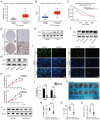
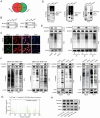
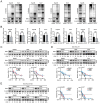
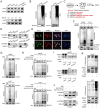

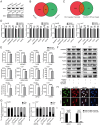

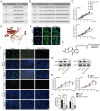
Similar articles
-
PTGES3 proteolysis using the liposomal peptide-PROTAC approach.Biol Direct. 2024 Dec 26;19(1):144. doi: 10.1186/s13062-024-00580-0. Biol Direct. 2024. PMID: 39726032 Free PMC article.
-
Deubiquitination of the repressor E2F6 by USP22 facilitates AKT activation and tumor growth in hepatocellular carcinoma.Cancer Lett. 2021 Oct 10;518:266-277. doi: 10.1016/j.canlet.2021.07.044. Epub 2021 Jul 30. Cancer Lett. 2021. PMID: 34339800
-
O-GlcNAcylation of SIX1 enhances its stability and promotes Hepatocellular Carcinoma Proliferation.Theranostics. 2020 Aug 2;10(21):9830-9842. doi: 10.7150/thno.45161. eCollection 2020. Theranostics. 2020. PMID: 32863962 Free PMC article.
-
Ubiquitin-specific protease 2a promotes hepatocellular carcinoma progression via deubiquitination and stabilization of RAB1A.Cell Oncol (Dordr). 2021 Apr;44(2):329-343. doi: 10.1007/s13402-020-00568-8. Epub 2020 Oct 19. Cell Oncol (Dordr). 2021. PMID: 33074477
-
O-GlcNAc modified-TIP60/KAT5 is required for PCK1 deficiency-induced HCC metastasis.Oncogene. 2021 Dec;40(50):6707-6719. doi: 10.1038/s41388-021-02058-z. Epub 2021 Oct 14. Oncogene. 2021. PMID: 34650217 Free PMC article.
Cited by
-
The Peptide PROTAC Modality: A New Strategy for Drug Discovery.MedComm (2020). 2025 Mar 24;6(4):e70133. doi: 10.1002/mco2.70133. eCollection 2025 Apr. MedComm (2020). 2025. PMID: 40135198 Free PMC article. Review.
-
PTGES3 proteolysis using the liposomal peptide-PROTAC approach.Biol Direct. 2024 Dec 26;19(1):144. doi: 10.1186/s13062-024-00580-0. Biol Direct. 2024. PMID: 39726032 Free PMC article.
References
-
- Llovet JM, Kelley RK, Villanueva A, Singal AG, Pikarsky E, Roayaie S. et al. Hepatocellular carcinoma. Nature Reviews Disease Primers. 2021;7:6. - PubMed
-
- Xu Y, Chou KC. Recent Progress in Predicting Posttranslational Modification Sites in Proteins. Current Topics in Medicinal Chemistry. 2016;16:591–603. - PubMed
-
- Shi J, Ruijtenbeek R, Pieters RJ. Demystifying O-GlcNAcylation: hints from peptide substrates. Glycobiology. 2018;28:814–24. - PubMed
MeSH terms
Substances
LinkOut - more resources
Full Text Sources
Medical
Molecular Biology Databases
Miscellaneous

